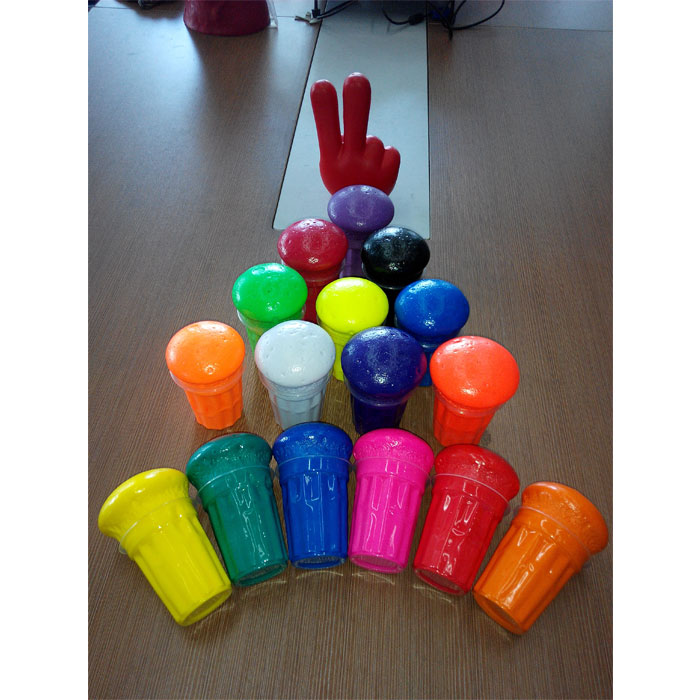Poliüretan elastomer formed by the polymerization reaction of diisocyanate and active hydrogen compound, the rigid segment containing urea group composed of diisocyanate and diamine chain extender, the glass transition temperature is much higher than room temperature, and it is glassy at room temperature. Subcrystals or microcrystals form the plastic phase; flexible segments of polyether or polyester are gathered together to form the matrix or matrix of the poliüretan rubber. Because its glass transition temperature is lower than room temperature, it is called the rubber phase. The microphase separation of the poliüretan elastomer makes the poliüretan elastomer have the advantages of good wear resistance, wide range of hardness, high strength and high elongation, large load supporting capacity, good shock absorption effect and excellent oil resistance. Choosing a suitable molding and processing method can maximize the performance of poliüretan elastomers and prepare various poliüretan elastomers with excellent properties, which are widely used as plastics, rubber, fibers, adhesives and coatings, and even as functional polymer materials. Such as medical poliüretanmalzemeler.
1.1 Şekillendirme işleme yöntemlerinin seçilmesi için genel ilkeler
(1) Kalıplama işlemi genellikle bir polimer bileşiğini katı halde (toz veya granül), macun veya çözelti halinde eritmek veya deforme etmek ve bir kalıp aracılığıyla istenen şekli oluşturmak ve elde edilen şekli korumak ve sonunda elde etmek içindir. ürün. zanaat süreci.
(2) Ortak kalıplama işleme akışı: â' Ürün üretmek için polimer bileşik karışımını bir ve iki kez oluşturma yöntemi; â'¡Tek seferde ürün üretmek için polimer bileşiği oluşturma yöntemi; • Tek adımda monomer karışımından ürün üretme yöntemi • Tek adımda oligomer karışımı üretim yöntemi.
(3) İşleme performansı ve etkileyen faktörler: â' Ekstrüderde, enjeksiyon makinesinin namlusunda, kalender silindirlerinde ve kalıpta sıkıştırılabilirlik, malzeme ekstrüzyonla deforme olduğunda malzemenin şekli elde edilir. ve sürdürme yeteneği. Kısıtlayıcı faktörleri: eriyik viskozitesi, işleme ekipmanı yapısı, eriyik reolojisi ve eriyik akış hızı. Kalıplanabilirlik, enjeksiyon makinesi, ekstrüder ve sıkıştırma makinesinin etkisi altındaki kalıplama işleminde, malzemenin sıcaklık ve basınç etkisi altında deforme olması ve kalıpta kalıplanabilme özelliği. Kısıtlayıcı faktörleri: reoloji, termal özellikler ve diğer fiziksel ve mekanik özellikler ve polimer bileşiklerinin kimyasal reaktivitesi. Genişletilebilirlik, perdahlama veya gerdirme sırasında, malzeme perdahlama veya bir veya iki yönde gerdirme yoluyla deforme olur. Kısıtlayıcı faktörleri: malzemenin plastisitesi ve gerinim sertleştirme etkisi. Eğirilebilirlik, ekstrüzyon kalıplama sırasında meme, malzemenin kalıplama yoluyla sürekli katı lifler oluşturma yeteneği. Kısıtlayıcı faktörleri: reoloji, eriyik viskozitesi ve mukavemeti, termal stabilite ve kimyasal stabilite.
1.2 Kalıplama ve işleme yöntemlerinin seçilmesi için genel ilkelerpoliüretanelastomerler
Poliüretan elastomer molding processing system is divided into liquid system and solid system. On the basis of the rapid polymerization reaction of diisocyanate and active hydrogen compound, the molding processing method is conducive to the microphase separation of the poliüretan elastomer. , Liquid system, poliüretan casting glue can be processed by casting (manual casting, centrifugal casting and vacuum casting), reaction injection molding, spraying, knife coating, roller coating, laminating, laminating, bonding, vulcanizing, pasting and rubbing ; Solid system, poliüretan compound rubber can be vulcanized and laminated with mold, poliüretan thermoplastic can be used with thermoplastic, hot injection, calendering, blow molding, spinning and lamination.
1.3 Temel tiplerin ve kalıplama işleme yöntemlerinin uyum ilkesi
Poliüretanelastomer, modülü açısından plastik ve kauçuk arasında yüksek bir polimerdir. Esas olarak içerirpoliüretan compound rubber, poliüretan cast rubber, poliüretan water emulsion and poliüretan thermoplastic. Poliüretan leather, poliüretan adhesives, poliüretan coatings, poliüretan compounds, poliüretan casting glues, poliüretan fibers, poliüretan water emulsions and poliüretan thermoplastics are all derived from the above four types of glue. The molding and processing methods of poliüretan compound rubber, poliüretan water emulsion and poliüretan thermoplastic generally belong to the molding processing methods of rubber, coatings and plastics.
1.4 The use of poliüretan elastomers and the matching principle of production continuity and molding processing methods
Poliüretan elastomer molding and processing methods are matched with the use of poliüretan elastomers, taking into account the continuity of production. For example, poliüretan leather molding methods usually use poliüretan casting adhesive or foaming layer, poliüretan water emulsion and poliüretan thermoplastic as the surface layer; also available Poliüretan thermoplastic and poliüretan water emulsion are used as leather separately, which are based on the basic rubber molding processing method, supplemented by foam molding processing, usually calender molding processing method is selected. Poliüretan paving materials are made of poliüretan casting glue, mainly due to the large product shape and low precision requirements. Medical poliüretan materials have good chemical stability, tissue compatibility, and resistance to biological aging, so the molding process uses dip coating, pouring and coating methods.


